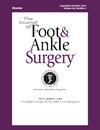后踝骨折的直接或间接复位内固定:一项系统回顾和荟萃分析。
IF 1.3
4区 医学
Q2 Medicine
引用次数: 0
摘要
后踝关节骨折的直接或间接内固定仍然是一个有争议的话题。虽然直接钢板或螺钉内固定被认为能提供更好的复位,但也可能造成更严重的软组织损伤,而间接螺钉内固定被认为损伤较小,但可能存在复位不良的风险。我们进行了这项荟萃分析,以调查直接复位内固定与间接复位内固定治疗踝关节后骨折的临床疗效和安全性。采用PRISMA (Preferred Reporting Items for Systematic Evaluation and Meta-Analysis)指南,检索中国知网(CNKI)、PubMed、Web of Science、Embase等数据库自成立之年起至2025年2月,人工检索相关期刊,收集相关文献,筛选并分析符合要求的文章。采用RevMan 5.4软件进行meta分析,无法综合纳入研究的数据时进行系统评价。共纳入17篇文献,涉及1538名研究对象,结果显示,直接钢板或螺钉复位固定与间接螺钉复位固定后踝关节骨折在术后AOFAS评分、并发症、背屈限制等方面无统计学差异;然而,放射学评价>2mm和骨关节炎(P本文章由计算机程序翻译,如有差异,请以英文原文为准。
Direct or indirect reduction internal fixation for posterior ankle fractures: A systematic review and meta-analysis
Direct or indirect internal fixation for posterior ankle fractures remains a controversial topic. While direct plate or screw internal fixation is believed to provide better reduction, it may also cause more severe soft tissue damage, while indirect screw internal fixation is thought to result in less damage but may carry the risk of poor reduction. We conducted this meta-analysis to investigate the clinical efficacy and safety of direct versus indirect reduction internal fixation for posterior ankle fractures. The Preferred Reporting Items for Systematic Evaluation and Meta-Analysis (PRISMA) guidelines were used to search the China Knowledge Network database (CNKI), PubMed, Web of Science, Embase, and other databases from the year of establishment- February 2025, and relevant journals were manually searched to collect the relevant literature, and articles that met the requirements were screened and analyzed. Meta-analysis was conducted using RevMan 5.4 software, and a systematic evaluation was carried out when the data from the included studies could not be synthesized. A total of 17 articles involving 1538 study subjects were included, and the results showed that there were no statistical differences in postoperative AOFAS scores, complications, and Dorsiflexion restriction between ankle fractures after direct plate or screw reduction and fixation and those after indirect screw reduction and fixation; however, the Radiological evaluation>2 mm and Osteoarthritis (P < 0.05) were statistically different. Direct reduction and fixation of posterior ankle fractures has better imaging performance and reduces the incidence of postoperative arthritic events.
求助全文
通过发布文献求助,成功后即可免费获取论文全文。
去求助
来源期刊

Journal of Foot & Ankle Surgery
ORTHOPEDICS-SURGERY
CiteScore
2.30
自引率
7.70%
发文量
234
审稿时长
29.8 weeks
期刊介绍:
The Journal of Foot & Ankle Surgery is the leading source for original, clinically-focused articles on the surgical and medical management of the foot and ankle. Each bi-monthly, peer-reviewed issue addresses relevant topics to the profession, such as: adult reconstruction of the forefoot; adult reconstruction of the hindfoot and ankle; diabetes; medicine/rheumatology; pediatrics; research; sports medicine; trauma; and tumors.
 求助内容:
求助内容: 应助结果提醒方式:
应助结果提醒方式:


